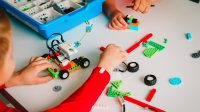How Robotics Can Help Students in Special Education Learn Social Skills
Combining robotics instruction with social stories can help students figure out how to navigate friendship.
Your content has been saved!
Go to My Saved Content.Social skills enable us to interact and communicate with others. They allow us to build and maintain friendships as well as process and implement conflict resolution strategies. Many teachers expect students to come into school with these skills. However, as a primary elementary special education teacher, I know that my students with disabilities—especially those with a primary diagnosis of autism or emotional disturbance—need to be explicitly taught social skills through social stories instruction.
Students with disabilities often need additional support when it comes to taking turns, sharing a preferred item, navigating directional tasks, participating in fire or shelter-in-place drills, and building and maintaining friendships.
Combining Robotics and Social Skills
Last year, my school started a robotics program, which I’ve been using to provide social skills instruction and increase student engagement. The activity begins with students reading or listening to a social story on friendship. I then ask students to create an anchor chart as a whole group that describes what friendship should look like (getting along), sound like (talking, laughing, smiling) and even feel like (happiness) that can be displayed in the classroom and easily referred to.
An unplugged activity, such as an interactive bulletin board, enables students to physically move pieces through a social skills scenario or social story from one area to another while focusing on how many turns or steps are needed to get to the end. You’ll need chart paper, markers, an interactive bulletin board display (I repurposed an old wall calendar), Velcro, copies of directional buttons, a planning page, and a read-aloud story on a designated social skill. To enhance the lesson, you can include photographs of your students, but that’s optional.
To prepare for the activity, print out copies of directional buttons—left, right, forward, and backward—and put Velcro on the backs. Students can manipulate them on the interactive bulletin board via Velcro, and they can use a planning page that assists with organization as well as enables them to visually “debug” their code before they transfer the copies of the buttons onto the bulletin board. The planning page will also show which directional buttons the students are going to use and the route that they will take.
Next, the students take turns navigating the pictures of themselves (if you chose to include pictures) around the bulletin board to their friend on the opposite side while “coding” or moving to pictures that demonstrate friendship.
The robots we use from VEX Robotics have the directions on them, which makes this activity much easier for students. Younger students may struggle a bit if they don’t know their left from their right. Timelines for learning robotics are very individualized to the student and can be differentiated easily. Some students learn how to code with touch within a week and can move on, while others may take longer. Robotics instruction can be presented to the whole group, small groups, or individuals, and is a great center activity as well.
Coding by touch enables students to demonstrate their knowledge of the social skill, and the unplugged activity lends itself to further discussion about why students chose the route that they did around the board. It also helps them to understand that there may be different ways to demonstrate friendship, but each one ultimately ends up with a similar outcome.
From Analog to Digital
Through scaffolding opportunities, students will use their prior knowledge of unplugged activities to start handling a small robot that requires coding of touch buttons to begin moving through a given scenario. To maintain consistency and routine, I have students use the same pictures demonstrating friendship as the activity above along with the planning page. However, this time, I place the pictures on a square field tile, and students need to manipulate and code utilizing the touch buttons on the robot (forward, backward, left, right) to navigate a photograph of themselves to their friend.
After they master coding with touch, students begin coding with coding cards (transparent cards with text) and a remote coder that connects to their robot to execute their code again utilizing the same picture cards.
Finally, the students are able to utilize a web-based, block-coding program to enable the movement of their robot to their friend on the tile field. This activity not only lends itself to repetitive practice opportunities but can serve as a formative assessment or exit ticket activity.
The level of difficulty does increase with the coder cards as the students read simple commands such as “drive 1, turn right, or stop.” In addition to the words, there are also pictures to depict what operation is presented for emergent readers.
A benefit of implementing robotics to assist in social skills instruction is that the execution can be differentiated for students. Students who have fine-motor concerns can more easily participate in the unplugged activity by physically manipulating the picture cards. Those with more advanced fine-motor skills may master coding of touch buttons and be ready to demonstrate their knowledge of coding and debugging through the coder cards. But all of them learn the same social skills and demonstrate high levels of student engagement.
This engaging and simple idea also lends itself to monitoring of individualized education plan goals through teaching of social skills that students with special needs often require.
